Primo Customized Values Usage
- Last updated
- Save as PDF
-
How many times did users invoke a certain action in Primo that are associated with usage actions that have dynamic values for collections and resource type filter bars?
-
How often were users signed-in when they invoked a certain action?
-
On average how many times are specific actions invoked in a single session?
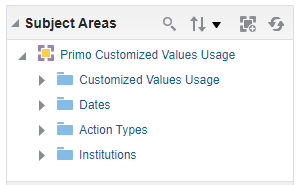
-
Because Analytics data is aggregated daily based on the UTC time zone, yesterday's data for your library may only contain a partial reporting and may require an additional day to see its full reporting.
-
Some actions such as filtering by facets or by resource types in the Resource Type Filter Bar may also be triggered by deep links and may not be invoked directly by users.
Customized Values Usage Table
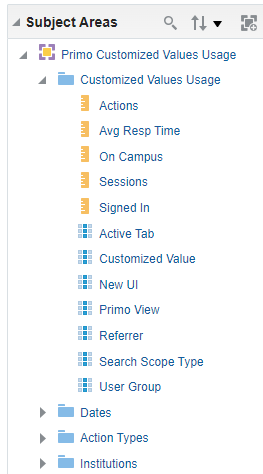
| Field | Description |
|---|---|
|
Actions
|
A measurement field that tracks the number of times an action was taken.
|
|
Avg Resp Time |
A measurement field that tracks the average response time for the action taken. |
|
Customized Value |
A search attribute field that contains the dynamic name of the collection or resource type filter bar. |
|
Sessions
|
A measurement field that tracks the number of sessions in which an action was taken.
Sessions are counted only one per action. For example, if the user ran two searches in the same session – the session is only counted once.
Note that if you total the number of sessions in the Actions table, the total is greater than the number of sessions for the same period in the Sessions table – since the same session is counted more than once.
|
|
Signed-in
|
A measurement field that tracks the number of times an action was taken from a user who was signed-in.
|
|
On Campus
|
A measurement field that tracks the number of times an action was taken from a user who was on campus.
This field is available with the November 2015 release.
Primo users are considered on-campus if they are within the defined IP range for the institution. For more details, see Configuring IP Ranges for a Library.
|
|
Primo View
|
An attribute field that stores the view in which the action was performed.
This attribute is available with the July 2015 release. Actions that predate this release do not have this attribute. |
|
Active Tab
|
An attribute field that stores the tab in which the following search actions were performed: basic search, basic search with pre-filters, and advanced search.
This attribute is available with the November 2015 release. Actions that predate this release do not have this attribute. |
|
Search Scope Type
|
A search attribute field that indicates which type of search scope was used in the search. A search scope type is provided for search and results list actions. For all other actions, the search scope type has a null value.
The Search scope type has the following values:
The Search Scope Type has been added in the July 2015 release. Actions that predate the installation of this release do not have this attribute. |
|
New UI |
A search attribute field that indicates whether the new UI was used in the search. The valid values are Yes or No. |
|
User Group |
A search attribute field that indicates the user group of the user. New UI: Reports display the User Group codes that were received from the authentication system, not the mapping table used for the Classic UI. For users who have not signed in, the report displays the Guest user group.
Classic UI: The User Groups for Primo Analytics mapping table defines the user groups that display in the reports. A user's group is determined as follows:
For more details, see User Groups for Primo Analytics.
|
| Referrer |
A search attribute field that contains the referrer information (such as Google Scholar, Yahoo, and Primo), which indicates how users are accessing information from the Primo Front End.
This attribute has been added in the May 2016 release. Actions that predate the installation of this release do not have this attribute.
|
Dates Table
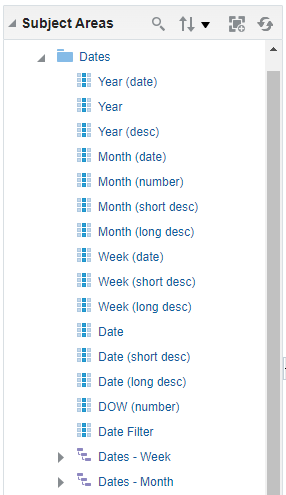
The following table provides an example for each month format.
| Date Option | Example Format |
|---|---|
| Year (date), Year, Year (desc) | Displays the year: 2017 |
| Month (date), Month (short desc) | Displays the month and year: Mar 2017 |
| Month (long desc) | Displays the full month name and year: March 2017 |
| Month (number) | Displays the month number: 3 (displays for March) |
| Week (date), Week (short desc) | Displays the month and first day of the week: Mar 13 |
| Week (long desc) | Displays the month, first day of the week, and year: Mar 13, 2017 |
| Date | Displays the date of occurrence: Mar 15 |
| Date (short desc) | Displays the day and date of occurrence: Wed, Mar 15 |
| Date (long desc) | Displays the day, date, and year of occurrence: Wed, Mar 15, 2017 |
| DOW (number) | Displays the number of the week on which the event occurred: 4 (displays for Wednesday) |
| Date Filter | Displays information based on the following time periods:
|
| Dates - Week | Enables you to drill-down based on the following hierarchy: All Dates, Year, Week (long desc), and Date (long desc). |
| Dates - Month | Enables you to drill-down based on the following hierarchy: All Dates, Year, Month (date), and Date (long desc). |
Action Types Table
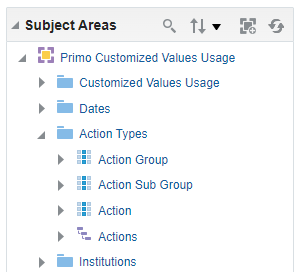
| Field | Description |
|---|---|
|
Action Group
|
An attribute field that divides actions into groups.
See Action Attributes by Group and Subgroup for list of Actions groups.
|
|
Action Sub Group
|
An attribute field that divides actions into subgroups.
See Action Attributes by Group and Subgroup for list of Action subgroups.
|
|
Action
|
An attribute field for the type of action.
See Action Attributes by Group and Subgroup for a list of actions.
|
|
Actions
|
A hierarchical attribute field in which actions are organized into groups and subgroups.
|
Action Attribute Groups
Document Group
| Subgroup | Action | Description |
|---|---|---|
|
Link For an example, see How to create Analytics report to show how many times CDI Quicklinks were used per provider. |
Link to HTML fulltext using CDI Quicklink |
The user selected a CDI Quicklink to the HTML version of the full text from a specific provider. |
|
Link to PDF fulltext using CDI Quicklink |
The user selected a CDI Quicklink to the PDF version of the full text from a specific provider. |
|
|
Filters Bar |
Clicking on a resource type filter bar - <name of filter 1-11> |
The user selected a specific filter from the Resource Type Filter Bar. |
Collection Discovery Group
Institutions Table
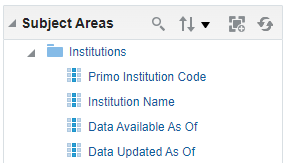
The following table lists the fields provided by the Institutions fact table.
| Field | Description |
|---|---|
|
Primo Institution Code |
The institution's code. |
|
Institution Name |
The institution's name. |
|
Data Available As Of |
The date (UTC time zone) on which data became available. |
|
Data Updated As Of |
The date (UTC time zone) on which the data was last updated. |

